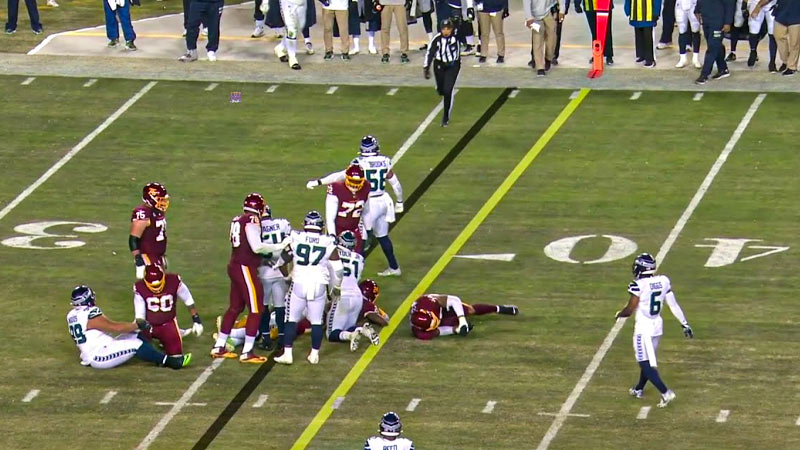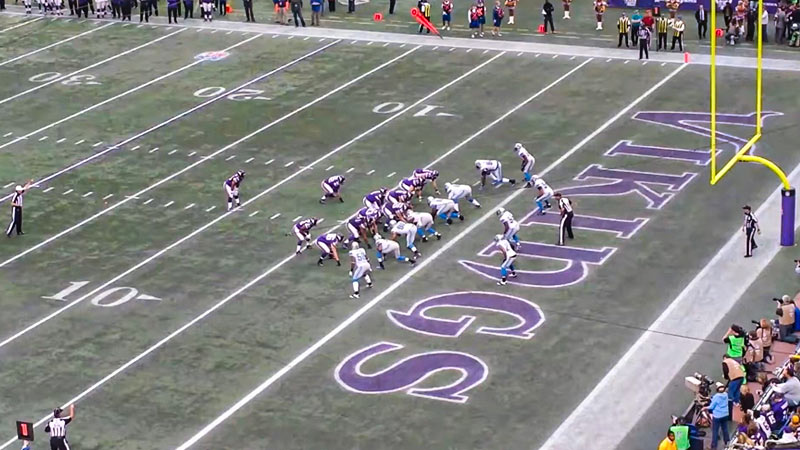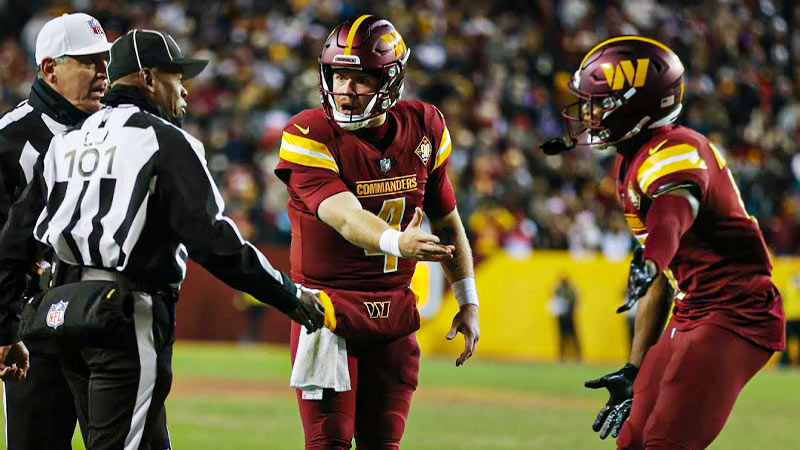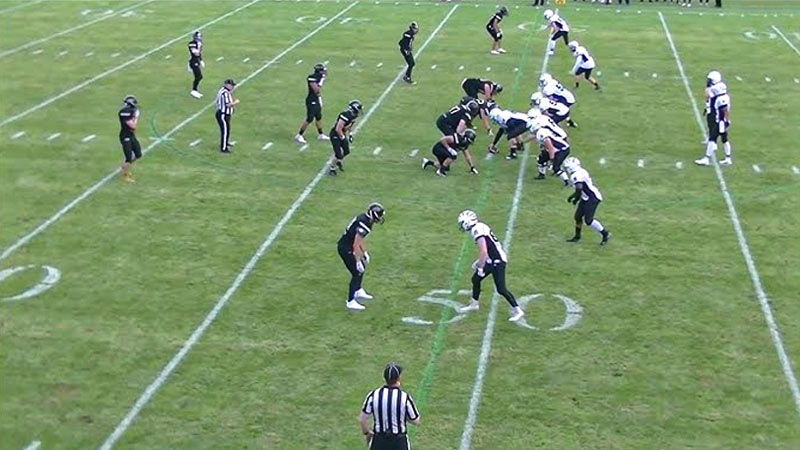Football is a game of precise rules and intricate strategies, where every aspect of the game is meticulously regulated to ensure fair play. Among the myriad rules that govern this sport, the concept of an “Illegal Formation” stands out as a crucial element in maintaining the integrity of the game.
An Illegal Formation in Football refers to a situation where the offensive team lines up in a way that violates the specific rules and requirements set by the league or governing body.
This can involve having too few or too many players on the line of scrimmage, improper positioning, or other infractions.
Understanding what constitutes an Illegal Formation is essential for both players and fans, as it has significant consequences on the flow of the game, including penalties, loss of down, and potential nullification of plays.
In this exploration, we delve into what is an illegal formation in American football to shed light on its importance in the world of football.
What Is An Illegal Formation In Football?
In football, an illegal formation refers to an offensive formation that does not adhere to the specific rules and requirements set by the governing body, typically the National Football League (NFL) or other league organizations.
The rules governing formations are designed to ensure fair play, prevent deception, and maintain a level playing field between the offense and defense.
An illegal formation can occur for various reasons, such as having too few or too many players on the line of scrimmage, players lining up in the wrong positions, or not having enough players in the backfield.
Common infractions include having ineligible receivers (usually offensive linemen) positioned too far downfield or failing to have a required number of players on the line of scrimmage.
Penalties for illegal formations usually result in the loss of five yards and a replay of the down. While it may seem like a minor infraction, illegal formations can disrupt offensive plays, lead to wasted opportunities, and hinder a team’s progress down the field.
Therefore, teams and coaches must meticulously follow formation rules to avoid costly penalties and maintain a cohesive offensive strategy.
What Makes An Illegal Formation In Football?
Here’s some necessary explanation of what makes an illegal formation in football:
Insufficient Players on the Line of Scrimmage

An offensive formation must have at least seven players lined up on the line of scrimmage at the snap. If there are fewer than seven players, it constitutes an illegal formation.
This rule ensures that the offense has a fair number of players to engage the defense effectively.
Too Many Players on the Line of Scrimmage
Conversely, if the offense has more than four players in the backfield, it is considered an illegal formation. Players in the backfield are those not on the line of scrimmage.
Having too many players in the backfield can create confusion and unfair advantages, hence the penalty.
Ineligible Receiver Downfield
Offensive linemen, typically those wearing jersey numbers 50-79, are ineligible to catch passes. If an ineligible receiver is positioned more than one yard downfield at the time of the pass, it results in an illegal formation.
This rule maintains fairness and prevents trick plays involving linemen catching passes.
Illegal Formation by the Wide Receiver
If a wide receiver is not positioned correctly, such as lining up off the line of scrimmage or covering an eligible tight end, it constitutes an illegal formation.
Proper alignment ensures that eligible receivers are clearly identifiable and prevents confusion for the defense.
Players Not Set for One Second
Before the snap, all players must be set for at least one full second. If any player goes in motion or adjusts their position before everyone is set, it leads to an illegal formation.
This rule aims to prevent players from gaining unfair advantages through sudden movements.
Players Covering the Center
During field goal or extra point attempts, it is illegal for defensive players to line up directly over the snapper. This formation is prohibited to protect the snapper and ensure a fair chance to execute the kick. Violating this rule results in a penalty against the defense.
Illegal Shift or Motion
If players are in motion but do not come to a complete stop for one second before the snap, or if multiple players are in motion simultaneously, it constitutes an illegal shift or motion.
A properly executed motion can confuse the defense, but it must comply with the rules to avoid penalties.
Adherence to these formation rules is vital in American football, ensuring fair play, preventing deception, and maintaining the integrity of the game.
Penalties for illegal formations often result in lost yards, disrupted plays, and potential turnovers, emphasizing the importance of players and coaches understanding and following these regulations.
What Are Some Historical Examples Of An Illegal Formation In Football?

While illegal formations in football can vary based on rule changes and interpretations, here are some historical examples that illustrate different aspects of illegal formations:
Seven Men on the Line of Scrimmage
In 1946, the Cleveland Browns used a formation with seven men on the line of scrimmage instead of the required minimum of seven. The innovation was deemed illegal and later led to a rule change requiring seven players on the line.
Eligible Receiver Not Clearly Marked
In a 1977 playoff game, the Oakland Raiders famously executed a “Ghost to the Post” play, where tight end Dave Casper caught a game-tying touchdown pass. However, it was ruled illegal because Casper had not clearly declared himself as an eligible receiver.
Illegal Motion on the Line of Scrimmage
In a 2014 NFL game between the Kansas City Chiefs and San Diego Chargers, a touchdown pass was negated when wide receiver Dwayne Bowe was called for an illegal motion for moving towards the line of scrimmage before the snap.
Multiple Players in Motion
In 2007, the New England Patriots offense used a formation with multiple players in motion simultaneously, confusing the defense. The league later clarified rules regarding motion, limiting it to one player at a time.
Ineligible Receiver Downfield in College Football
In college football, illegal formations can involve ineligible receivers downfield. In 2017, the Clemson Tigers had a touchdown called back in the National Championship game when an offensive lineman was deemed too far downfield.
Formation Deception
In the 1981 AFC Championship game, the San Diego Chargers used a deceptive formation against the Cincinnati Bengals, leading to a touchdown. However, the league later clarified rules regarding deceptive formations to prevent confusion.
Illegal Shift Penalty
In a 2013 NFL game, the Minnesota Vikings were penalized for an illegal shift when multiple players were moving before the snap, leading to a lost down and yards. This illustrates the importance of proper alignment and motion.
These historical examples showcase various aspects of illegal formations, from ineligible receivers and improper motion to deceptive tactics.
Rule changes and clarifications have often followed such instances to ensure fair play and maintain the integrity of the game.
What Happens When An Illegal Formation Is Called In Football?

When an illegal formation is called in football, it results in penalties and consequences that can impact the flow of the game. Here are some consequences of an illegal formation:
Loss of Down
An illegal formation penalty results in a loss of down. This means that the offensive team forfeits one of their four opportunities (downs) to advance the ball ten yards.
For example, if it was first down when the penalty occurred, it becomes second down after the penalty is assessed.
Yardage Penalty
In addition to the loss of down, an illegal formation incurs a five-yard penalty. The ball is moved five yards backward from the original line of scrimmage, which can negatively impact field position and the offense’s ability to gain first downs.
Replay the Down
In some cases, particularly when an illegal formation occurs before the snap, the down is replayed. This means that the offensive team gets another attempt to run a play, but they still face the original distance needed for a first down.
Nullification of Play
If an illegal formation penalty is called after a play has been executed (e.g., a touchdown or a significant gain), the play is nullified, and the yardage gained is negated. This can be a significant setback for the offensive team.
Loss of Momentum
An illegal formation penalty can disrupt the momentum of an offensive drive. It can push the offense back, making it more challenging to convert first downs and potentially leading to punting or turning the ball over to the opposing team.
Repeat Offense
If a team repeatedly commits illegal formations during a game, the consequences become more severe. The officials may issue warnings or escalate penalties, such as loss of possession or ejection of a coach.
Defensive Option
In some cases, the defense may have the option to decline the penalty. They might choose this option if the result of the play (e.g., a sack or a turnover) is more favorable than the yardage penalty, loss of down, or replaying the down.
Overall, an illegal formation penalty in American football carries significant consequences that can disrupt offensive strategies, change field position, and potentially impact the outcome of the game.
It underscores the importance of proper alignment and adherence to the rules to maintain a fair and competitive contest.
FAQs
What Exactly Is an Illegal Formation in Football?
An Illegal Formation in American football occurs when the offensive team lines up in a way that violates specific rules and requirements set by the league.
Common infractions include having too few or too many players on the line of scrimmage, players lining up improperly, or players not adhering to their designated positions.
What Are the Consequences of an Illegal Formation?
Consequences of an Illegal Formation include a loss of down, a five-yard yardage penalty, and the potential nullification of plays. These penalties can disrupt offensive strategies, change field position, and even impact the outcome of the game.
How Does an Illegal Formation Impact Offensive Strategies?
An Illegal Formation can disrupt offensive strategies by pushing the team backward in terms of field position and downs. It can hinder their ability to gain first downs and potentially lead to turnovers or punting.
Are There Different Types of Illegal Formations?
Yes, there are various types of Illegal Formations, depending on the specific rule violated. These can include insufficient players on the line, too many players in the backfield, ineligible receivers downfield, and more.
How Can Teams Avoid Illegal Formations?
Teams can avoid Illegal Formations by ensuring that players line up correctly and adhere to the rules and regulations governing formations. Coaches and players must have a thorough understanding of the rules to maintain proper alignment and avoid penalties during a game.
Conclusion
In the grand mosaic of football, the concept of an Illegal Formation stands as a sentinel of the game’s integrity. It is a reminder that even in the midst of fierce competition, adherence to rules and regulations is paramount.
The consequences of an Illegal Formation extend far beyond a mere penalty; they can alter the course of a game, disrupt offensive strategies, and impact field position.
As we conclude our exploration, it becomes evident that the rules governing this sport are not mere technicalities; they are the very threads that weave the tapestry of fair play and sportsmanship.
To grasp the intricacies of an Illegal Formation is to understand the commitment to precision that defines football, ensuring that every game is contested on a level playing field where skill, strategy, and adherence to the rules reign supreme.







